Question
Which of the following combinations of person – city
– destination is correct? Study the below details and answer the following questions. Eight persons – A, B, C, D, E, F, G and H are going to four destinations viz., Delhi, Bangalore, Mumbai and Kolkata and they represent four different departments viz., Human Resources, Sales, Finance and Marketing but not necessarily in the same order. At least two persons belong to the same department and two of them visit the same destination. A belongs to the Finance department and he visits the same city as that of G. G doesn’t belong to the Finance, Marketing or Human Resources department. G doesn’t visit Kolkata or Mumbai. C visits Delhi and belongs to Human Resources department. The person who belongs to the Finance department other than A visits Delhi. B and G belongs to the same department. F visits Mumbai and he, doesn’t belongs to Sales and Marketing department. The two persons who belong to Marketing department visit Kolkata. D doesn’t belong to the Marketing department.Solution
A belongs to the Finance department and he visits the same city as that of G. G doesn’t visit Kolkata or Mumbai. So, he visits either Delhi or Bangalore. 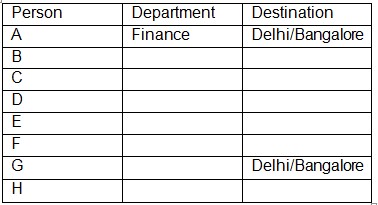 G doesn’t belong to the Finance, Marketing or Human Resources department. So, he belongs to Sales department.
G doesn’t belong to the Finance, Marketing or Human Resources department. So, he belongs to Sales department. 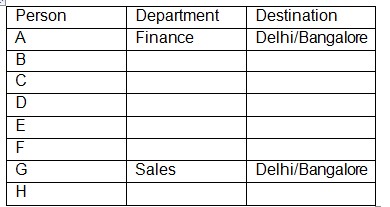 C visits Delhi and belongs to Human Resource department. Given, two persons visit same destination. So, A and G should travel to Bangalore.
C visits Delhi and belongs to Human Resource department. Given, two persons visit same destination. So, A and G should travel to Bangalore. 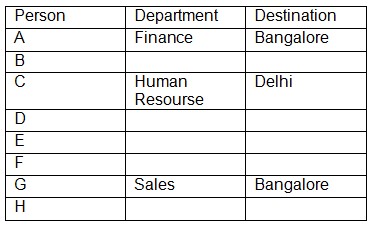 B and G belongs to the same department. So, B belongs to Sales department.
B and G belongs to the same department. So, B belongs to Sales department. 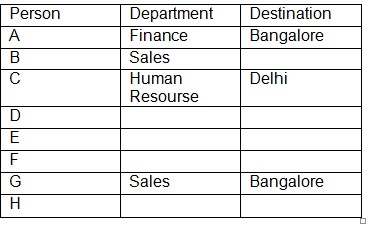 F visits Mumbai and he doesn’t belongs to Sales and Marketing department. So, he belongs to either Human Resources or Finance.
F visits Mumbai and he doesn’t belongs to Sales and Marketing department. So, he belongs to either Human Resources or Finance. 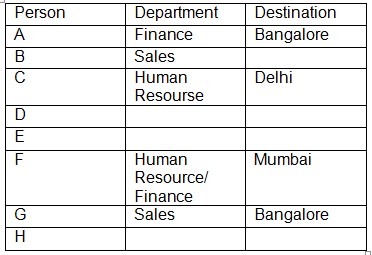 The two persons who belong to Marketing department visit Kolkata. D doesn’t belong to the Marketing department. Therefore, E and H belong to Marketing department and visit Kolkata.
The two persons who belong to Marketing department visit Kolkata. D doesn’t belong to the Marketing department. Therefore, E and H belong to Marketing department and visit Kolkata. 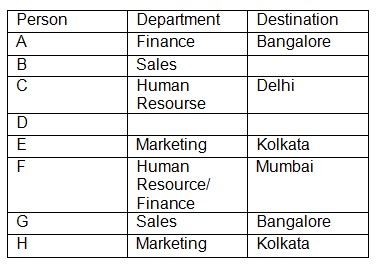 The person who belongs to the Finance department other than A visits Delhi. So, F belongs Human Resources. Therefore, D belongs to Finance and visits Delhi. B travel to Mumbai. The final arrangement will be as shown:
The person who belongs to the Finance department other than A visits Delhi. So, F belongs Human Resources. Therefore, D belongs to Finance and visits Delhi. B travel to Mumbai. The final arrangement will be as shown: 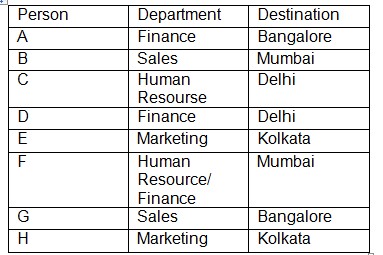
Sanchori cattle are found in which Indian state?
Match the Following
Inventions/Discovery Inventors/ Discover
(i) Heart – lung machine (A) Berline
(ii) Seismometer (B) John ...
Which Indian bank became the first major bank to join the Partnership for Carbon Accounting Financials (PCAF)?
1. Which of the following is not a permanent member of United Nation Security Council (UNSC)?
The 'Abolition of Titles' is a fundamental right classified under:
विष्व में सर्वाधिक लम्बी तट -रेखा किस खाडी की है ?
Below are two statements, one is a statement (A) and the other is a reason (R). Choose the correct answer from the options given below:
Statement...
Identify the INCORRECT statement regarding Payment Banks:
Where was the Namo Bharat Diwas celebrated recently?
The Uranium deposits are mostly found in which of the following mines of India?
Relevant for Exams:


